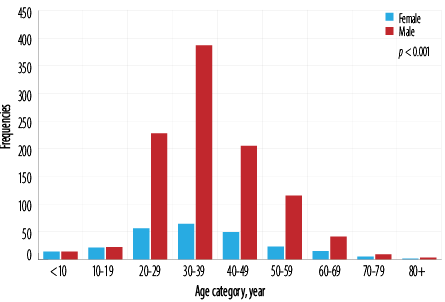Dear Editor,
In May 2020 issue of the Oman Medical Journal, Khamis et al,1 nicely characterized the epidemiological profiles of the first case series of patients with COVID-19 in Oman. Regrettably, the authors did not address the exact prevalence of COVID-19 in different age groups in the studied Omani population. However, on viewing Figure 2 in the study, the number of pediatric COVID-19 cases was much less than that in the adults.1 I assume that the actual pediatric COVID-19 cases were underestimated. COVID-19 in children is not receiving ample consideration and interest in many parts of the world because it wrongly seems irrelevant clinically and, therefore, epidemiological studies on pediatric COVID-19 are scarce. Nevertheless, the available data pointed out that children constituted 1–5% of diagnosed COVID-19 cases.2,3 I presume that the following points could contribute to the underestimation of pediatric COVID-19 in Oman.

Figure 2: Frequency distribution of Omani COVID-19 patients by age categories and gender.
First, as the majority of pediatric COVID-19 cases are asymptomatic or mildly affected,2,3 there is considerable probability that they will be away from the medical attention of treating pediatricians. The situation is further perplexed by limited knowledge and perceptions in many pediatricians on COVID-19 itself, resulting in falsely considering COVID-19 a simple, flu-like illness.
Second, the limited awareness of the public on the disease in terms of clinical presentation and transmission, as well as popular misbeliefs that the disease is confined to adults and children are not prone to contact and spread the disease to the community, could significantly contribute to disease transmission to people of different age groups, including children.
Third, the laboratory protocol for COVID-19 diagnosis is often performed on symptomatic patients or known contacts. Hence, it is not guaranteed that the small number of registered pediatric cases in the study reflects the magnitude of pediatric COVID-19.
Fourth, a nasopharyngeal swab is a crucial test to diagnose COVID-19. Interestingly, fecal viral shedding has been found to last longer than the nasopharyngeal shedding even in asymptomatic children, suggesting that it could play a vital role in spreading the disease.4 Documenting pediatric COVID-19 cases, therefore, necessitates both nasopharyngeal and rectal swab.
Finally, early detection, meticulous management of cases, increasing awareness of public and pediatricians, applying infection prevention lines, and vaccine advent (envisaged to be released soon) are fundamental to prevent the spike in the pediatric COVID-19 prevalence in Oman.
references
- 1. Khamis F, Al Rashidi B, Al-Zakwani I, Al Wahaibi AH, Al Awaidy ST. Epidemiology of COVID-19 infection in Oman: analysis of the first 1304 cases. Oman Med J 2020 May;35(3):e145.
- 2. Ludvigsson JF. Systematic review of COVID-19 in children shows milder cases and a better prognosis than adults. Acta Paediatr 2020 Jun;109(6):1088-1095.
- 3. Tezer H, Bedir Demirdağ T. Novel coronavirus disease (COVID-19) in children. Turk J Med Sci 2020 Apr;50(SI-1):592-603.
- 4. Xu Y, Li X, Zhu B, Liang H, Fang C, Gong Y, et al. Characteristics of pediatric SARS-CoV-2 infection and potential evidence for persistent fecal viral shedding. Nat Med 2020 Apr;26(4):502-505.